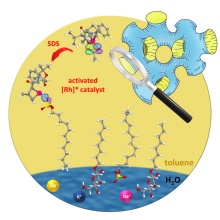Catalysis [Zarfishan Dilruba, Sadia Noor]
Among the current and future challenges are the sustainable use of energy and resources, thus efficient catalytic reactions are highly desirable. Chiral diene ligands offer a wide range of applications for asymmetric rhodium catalysis. Previously, rhodium-catalyzed C-H insertions, rearrangements and 1,2- and 1,4‑additions have been investigated.[1–4] The immobilization of corresponding catalysts on support materials offers the advantage that the ligands and expensive rhodium can be separated after catalysis and then reused. Within the framework of the CRC1333,[5] alkyne‑substituted norbornadiene and tetrahydropentalene ligands are to be selectively immobilized in the mesopores of various support materials via copper-catalyzed azide‑alkyne cycloaddition (CuAAC). The aim is to investigate whether the confinement of the pores leads to an improvement in selectivity compared to catalysis in the homogeneous media.[6]
[1] R.-T. Guo, Y.-L. Zhang, J.-J. Tian, K.-Y. Zhu, X.-C. Wang, Org. Lett. 2020, 22, 908–913.
[2] K. Okamoto, A. Nanya, A. Eguchi, K. Ohe, Angew. Chem. Int. Ed. 2018, 57, 1039–1043.
[3] M. Deimling, A. Zens, N. Park, C. Hess, S. Klenk, Z. Dilruba, A. Baro, S. Laschat, Synlett 2020, 31, A–U.
[4] M. Kirchhof, K. Gugeler, F. R. Fischer, M. Nowakowski, A. Bauer, S. Alvarez-Barcia, K. Abitaev, M. Schnierle, Y. Qawasmi, W. Frey, A. Baro, D. P. Estes, T. Sottmann, M. R. Ringenberg, B. Plietker, M. Bauer, J. Kästner, S. Laschat, Organometallics 2020, 39, 3131–3145.
[5] Link (November 2020).
[6] M. Deimling, M. Kirchhof, B. Schwager, Y. Qawasmi, A. Savin, T. Mühlhäuser, W. Frey, B. Claasen, A. Baro, T. Sottmann, S. Laschat, Chemistry – A European Journal 2019, 25, 9464–9476.



